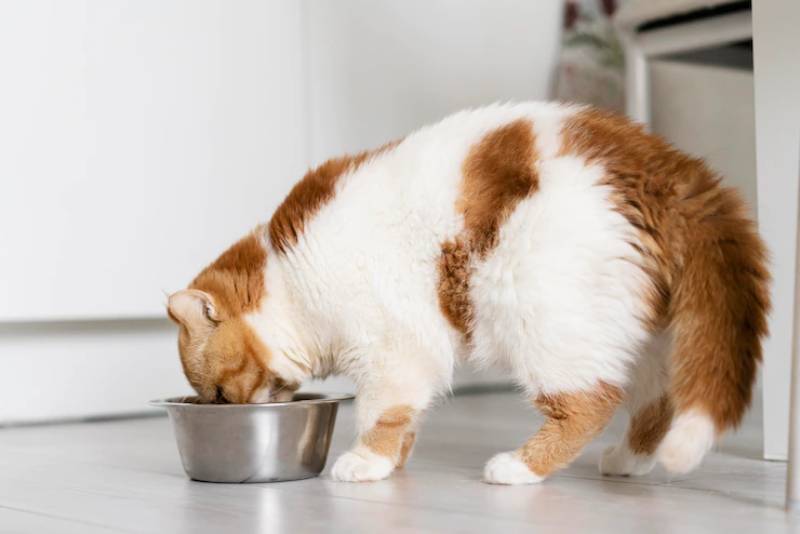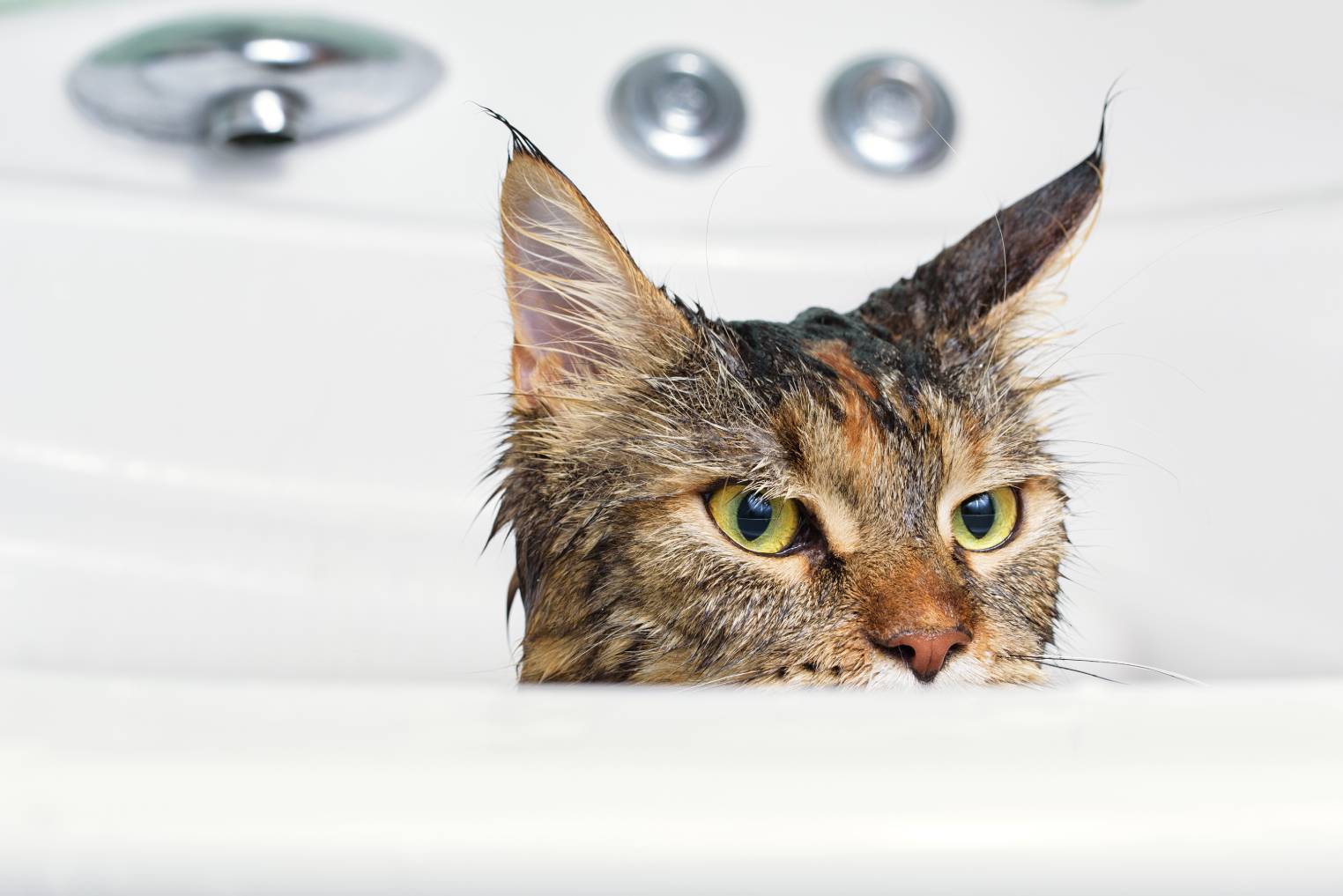How to Stop a Cat From Peeing On the Carpet: 9 Vet-Approved Tips & Advice
Updated on
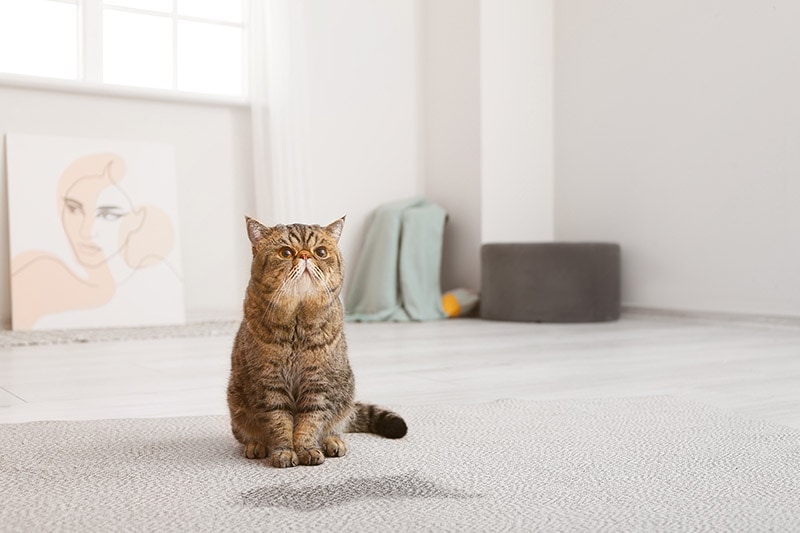
Of all the stains that could end up on your carpet, cat urine is one of the most challenging to manage. Alongside the smell, the stains are particularly frustrating because they’re rarely one-time occurrences. Behind every mark is a medical, environmental, or behavioral issue to solve if you don’t want more messes on the rug. If you’re scratching your head over your pet’s elimination issues, we’ll explain how to stop a cat from peeing on the carpet.
However, this article is not a replacement for veterinary advice, and it’s crucial to get your cat checked by the vet, as underlying health issues commonly lead to inappropriate urination and require medical treatment.
Why Is My Cat Peeing on the Carpet?
Elimination outside the litter box is rarely a random occurrence. Cats are clean characters and will fall into a litter routine as kittens once they see the value. If your cat is already litter box trained but now pees on the carpet, there’s an issue at play that typically falls into one of three categories:
- A health issue keeping them from getting to the box
- An external stressor in the environment
- A problem with the litter box or litter
Figuring out the issue might take some investigation and requires the valuable input of a veterinary professional, but you can be confident that every cause has a solution with dedication, time, and patience. A positive approach that rejects punishment is crucial here, as you need the cat’s trust to earn cooperation.
Your cat is not doing this to spite you; they are trying to tell you that something is not right with them in the only way they can. Training or lack of it is rarely the issue anyway. In most cases, stopping your cat from peeing comes down to correct identification of the underlying issue, with medical treatment possibly being required alongside better environmental maintenance and conversations with your vet.
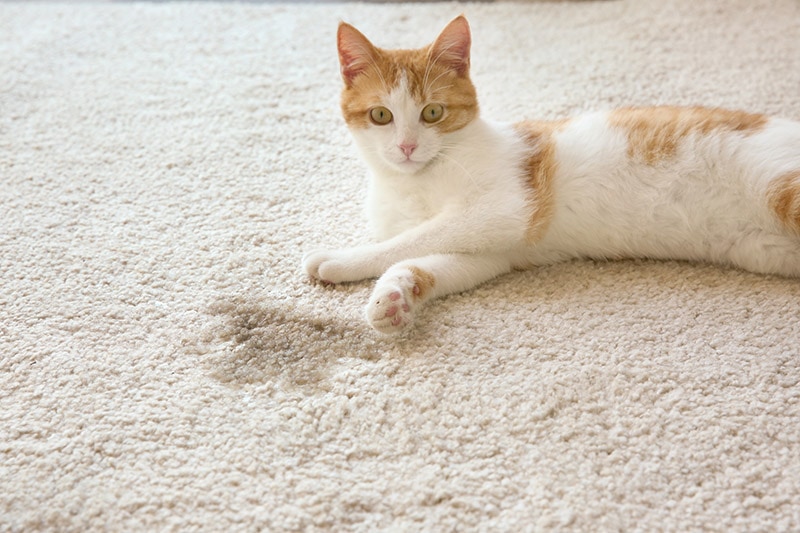
The 9 Tips on How to Stop a Cat From Peeing on the Carpet
If you have multiple cats in the house, the first step is identifying which one is peeing on the carpet. Sick or injured cats usually show other signs of illness and pain around the home, like limping, avoidance behaviors, meowing, reduced appetite, lethargy, or others. However, sometimes, discovering the culprit takes extra monitoring steps, such as:
- Setting up an inexpensive surveillance camera over the urination spot
- Observing cats in separate areas to assess individual elimination habits
- Working with your vet to administer a fluorescein capsule, although this may stain the carpet or be unsuccessful depending on urine pH value
When you know which cat is peeing, you can determine whether they’re urinating or marking. Cats have different body stances when spraying versus urinating, and spray is more likely to appear on walls and other vertical surfaces. Differentiating between the two will help you determine the cause and the solution to the issue.
1. Talk to Your Vet
Unacceptable elimination is often a sign of illness or injury if nothing has changed in the environment or routine. Several issues could cause urinary or mobility problems, including:
- Various causes of feline lower urinary tract disease
- Bladder stones or crystals
- Feline cystitis
- Diabetes
- Obesity
- Kidney disease
- Dementia
- Broken bones
- Arthritis
- Hyperthyroidism
Talk with your vet about your cat urinating on the carpet. They can reference medical histories while performing physical exams and subsequent bloodwork, urinalysis, X-rays, and other necessary diagnostic tests.
If underlying medical causes have been ruled out and the issue is due to anxiety and stress, it’s important to identify the cause for it. This is common in multi-cat households, and it’s crucial to have a sufficient number of litter boxes, hiding spots, toys, bowls and other resources, as cats are competitive.
Use of pheromone diffusers is also valuable to provide them with reassurance. A professional feline behaviorist’s advice should also be sought. In some cases, veterinarians may recommend further treatment on a case by case basis. Your vet can also offer advice for affecting the environment at home to help you stop your cat from urinating on the carpet.
2. Clean the Carpet With an Enzymatic Cleaner
Cats urinate in the same area to refresh their odor, as they have marked this area as familiar, and return as long as they can catch their scent. Unfortunately, many carpet cleaning solutions mask or temporarily remove the smell. Uric acid crystals fuse to fibers, releasing an ongoing odor whenever moisture reactivates them.
The best way to clean cat pee from the carpet and remove the scent entirely is with an enzymatic cleaner. Using enzymes and bacteria, these people and pet-friendly solutions target and consume the urine compounds that other cleaners can’t remove. Since they contain active agents, they continue eliminating any urine they can reach until the smell and stain are gone.
If the urine has gone down to the pad, you will need to replace it and potentially that section of carpet. The subfloor may need a thorough cleaning with an enzyme cleaner.
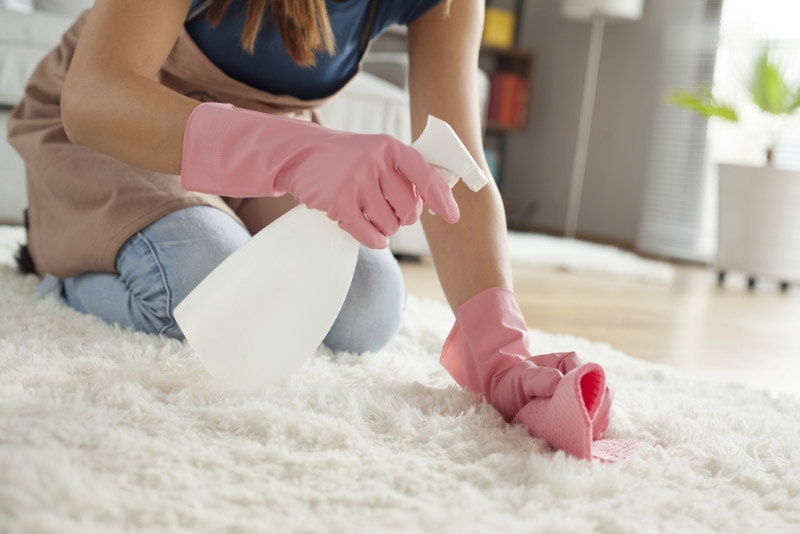
3. Block Off Access to the Spot
A cat’s location preference for the carpet can sometimes keep them from urinating in the box. Cats often go on the soft substrate and will continue using it even after you fix any litter box issues. In these instances, you must make the carpet undesirable or inaccessible.
Start by covering the spot where they urinate with off-putting materials like foil or plastic. This may not always work. You can also place the litter box on the carpet in the location they used for urinating, and when they use it, slowly move it to a more desirable location by making small moves each day. Another option is to place food bowls, toys, or beds in the same place, as this is likely to put your cat off from toileting there.
Blocking off the room may be necessary. Restrict access to a specific area, providing toys, food, scratch pads, and other enrichment to keep your cat stress-free in the rest of the house. Here, you can test different litter box setups to find one that works for your cat before slowly opening their access back to the area in question.

4. Reduce Your Cat’s Stress
Marking and inappropriate urinating on the rug might be due to anxiety. Outdoor cats can often distress pets, resulting in marking near doors or windows. Other cats or people in the house, different furniture arrangements, and changes in the routine could also be unnerving, or your cat may have separation anxiety when you leave home.
Minimizing access to stressors (e.g., closing blinds to prevent interactions with outdoor cats) is often the simplest solution. In a more general sense, environmental enrichment can mitigate anxiety. Ensure your cat has both physical and mental stimulation and security in their defined space. Offer toys, hiding spots, perches, trees, scratch pads, and puzzle games to keep your cat happy and relaxed while you’re away.
5. Clean the Litter Box
Most cats have a unique tolerance for a litter box’s dirtiness and will eventually avoid it if you neglect to clean it. You must scoop waste daily and clean the entire box at least once weekly.
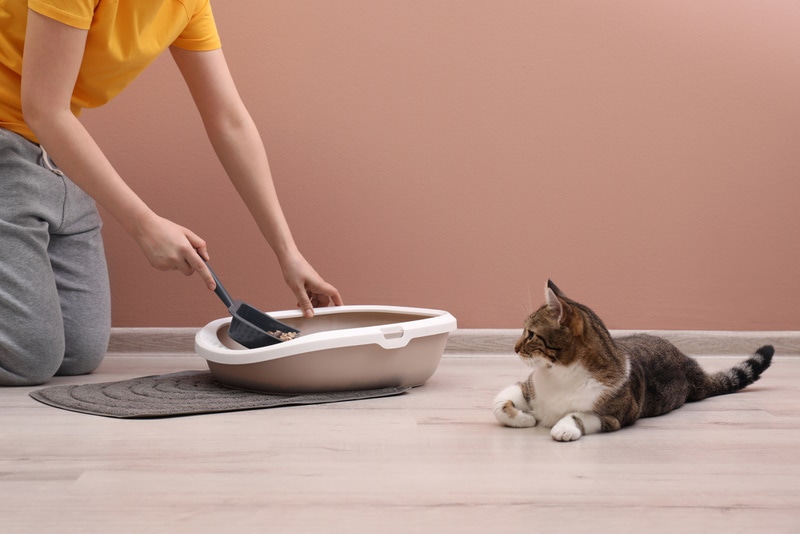
6. Move the Litter Box
Inappropriate urination rather than spraying may indicate an issue with the litter box. A location aversion occurs when the litter box is in a stressful area that doesn’t give your cat adequate privacy, security, or comfort. Loud noises like washing machines, air conditioners, or plumbing may startle your cat. If the box is too close to their food and water dishes, they may avoid it for sanitary reasons.
Older cats and those with mobility issues could have trouble getting to the litter box if the walls are too high. Always keep an extra litter box to give your cat easier access wherever they are in the house. Multi-level homes should have at least one box per floor.
7. Improve the Litter Box
As with the location, cats may not enjoy the litter box design or the litter. Cats perform specific, multi-step rituals while using the litter box, and disruptions to their process or off-putting setups can cause them to dismiss it entirely.
Assess the box. Ensure it is large enough for your cat to stand and turn around and the walls are low enough for them to step into it comfortably. If it’s covered, try an uncovered box, as cats often prefer one over the other.
Try different litters if you think your cat has a substrate aversion. Your cat may show their distaste for the litter by pawing the sides of the box and avoiding digging after peeing. Unscented, clumping litters are typically the most effective, but you can test several brands to find one your cat prefers.
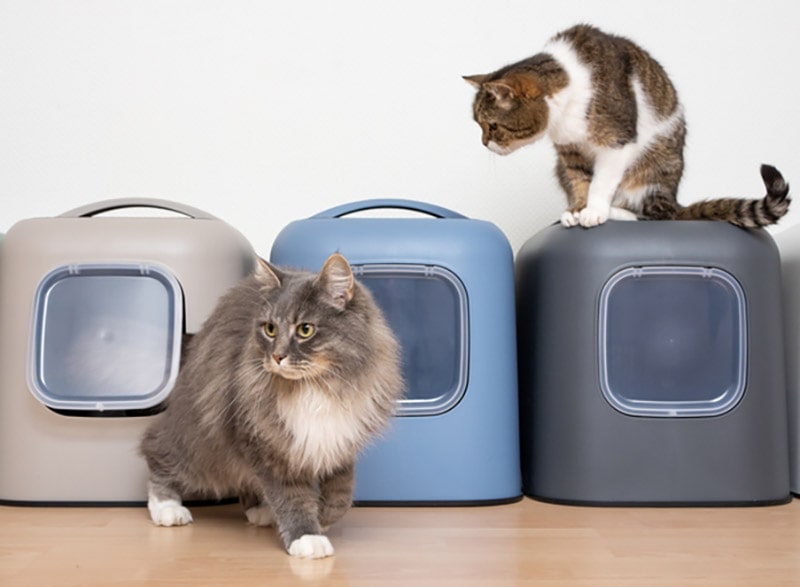
8. Prevent Competition Between Cats
Multi-cat households can create stress and competition in some or all of your pets, particularly if there are new introductions to the home. Cats might fight over litter boxes, causing one to avoid it entirely and urinate on the carpet instead. Territorial marking may also increase.
To prevent competition over limited resources, always have at least one litter box for every cat in the house, plus an extra. Each box should be in a separate quiet area with escape routes to stop cats from blocking access for others.
Proper introductions are critical in creating a satisfactory dynamic for all the cats in the household when you bring in new members. You may want to confine them to individual rooms and slowly trade scents until you can bring them together in supervised interactions.
9. Spay or Neuter Your Cat
Male and female cats spray to communicate with other animals for sexual, aggressive, or territorial purposes. Although stress can cause it in any cat, desexing significantly reduces spraying in up to 90% of males and 95% of females.
Final Thoughts
Cats peeing on the carpet is a complex issue requiring a patient, multifaceted solution and veterinary assessment. Early intervention is crucial to help your pet and save your rug. Whether it’s due to stress, discomfort, injury, or illness, inappropriate elimination means your cat is in trouble, and as a responsible owner, it’s your duty to take swift action to prevent a worsening and sometimes even life-threatening medical problem.
- Related Read: How to Get Rid of Fleas
Featured Image Credit: Pixel-Shot, Shutterstock


